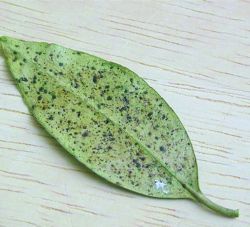Plant
Doctor Archive
Plague
of thrips
  CAN
you identify the tiny black creatures on the undersides of the leaves
on my camellia 'Fairy Wand'? CAN
you identify the tiny black creatures on the undersides of the leaves
on my camellia 'Fairy Wand'?
I thought it might be
spider mite, but can see no sign of any webbing. The plant is in
a part of our garden facing south, partially shaded by a water tank
and the leaves in the deep shade where the growth is longest seem
more affected by the pest. I have trimmed some of them back, but
the rest of the plant is covered in flower buds.
 THE
samples you sent were quite dried out, but from the black spots
and the silvery appearance of the leaves it is obvious the culprit
is thrips, not mites. Adult thrips are tiny black insects - the
young are even smaller and yellowish in colour. The black shiny
blobs that are easy to spot on the undersides of the leaves are
their excretions. THE
samples you sent were quite dried out, but from the black spots
and the silvery appearance of the leaves it is obvious the culprit
is thrips, not mites. Adult thrips are tiny black insects - the
young are even smaller and yellowish in colour. The black shiny
blobs that are easy to spot on the undersides of the leaves are
their excretions.
Thrips feed by rasping
away at the cells on the leaf surface and sucking up their contents.
The dead cells cause the characteristic silvery appearance of badly
affected leaves. Thrips thrive in warm, dry, sheltered conditions
and attack a wide range of shrubs. Badly affected leaves will eventually
die and drop off.
Cut back badly affected
shoots to encourage fresh new growth which should be relatively
free of the pest, for a while. Dispose of the prunings by burning
or put them in the rubbish. Prune surrounding plants to allow more
exposure to fresh air and rain, if possible. In hot, dry periods,
if practicable, set up an irrigation system to spray water over
the plants.
Garden thrips are relatively
susceptible to many of the commonly available sprays, so once flowering
is over, you could give the plant a thorough spray, especially the
undersides of the leaves, with a product like Mavrik, Confidor or
Rogor. You can add spraying oil, such as Conqueror or Clear White
Oil to the mix to enhance its effectiveness, but make sure to spray
on an overcast day or some foliage damage may occur.
Weekend
Gardener, Issue 196, 2006, Page 38
Reproduced with permission from the former Weekend Gardener magazine. The views expressed here are not necessarily those of the RNZIH.
|
 |
 |
|